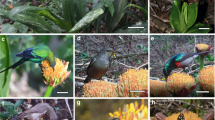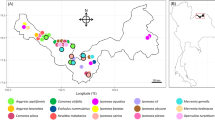Abstract.
We report the discovery of a new mechanism of pollination in orchids: transfer of pollinaria on the feet of birds. Observations carried out in South Africa and Malawi showed that the orchids Disa chrysostachya Sw. and Disa satyriopsis Kraenzl. are pollinated by sunbirds. Pollinaria of these orchids become attached firmly to the birds’ toes when they perch on the tall narrow inflorescences which are packed tightly with numerous small orange flowers. Birds typically perch on the lower part of an inflorescence while reaching up to feed on nectar in flowers on the upper part, but occasionally reverse this position to probe the lower flowers. The nectar is contained within a short bulbous spur with a narrow entrance that permits entrance of a sunbirds’ slender tongue. Contrary to expectation, the pollination mechanism in D. chrysostachya is remarkably efficient with about 6.1% of pollen reaching stigmas on other plants and fruit set occurring in 95% of flowers at one site. Birds seldom move their feet once perched, thus minimizing the incidence of self-pollination, either within or between flowers on an inflorescence.
Similar content being viewed by others
Author information
Authors and Affiliations
Corresponding author
Rights and permissions
About this article
Cite this article
Johnson, S., Brown, M. Transfer of pollinaria on birds’ feet: a new pollination system in orchids. Plant Syst. Evol. 244, 181–188 (2004). https://doi.org/10.1007/s00606-003-0106-y
Received:
Published:
Issue Date:
DOI: https://doi.org/10.1007/s00606-003-0106-y




